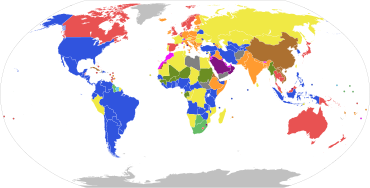
Back Regering Afrikaans Regierung ALS መንግሥት Amharic Gubierno AN Rīcscipe ANG حكومة Arabic ܫܘܠܛܢܘܬܐ (ܫܘܬܐܣܐ) ARC حوكومة ARY حكومه ARZ চৰকাৰ Assamese

Parliamentary systems: Head of government is elected or nominated by and accountable to the legislature
Presidential system: Head of government (president) is popularly elected and independent of the legislature
Hybrid systems:
Other systems:
Note: this chart represents the de jure systems of government, not the de facto degree of democracy.
| Part of a series on |
| Governance |
|---|
A government is the system or group of people governing an organized community, generally a state.
In the case of its broad associative definition, government normally consists of legislature, executive, and judiciary. Government is a means by which organizational policies are enforced, as well as a mechanism for determining policy. In many countries, the government has a kind of constitution, a statement of its governing principles and philosophy.
While all types of organizations have governance, the term government is often used more specifically to refer to the approximately 200 independent national governments and subsidiary organizations.
The main types of modern political systems recognized are democracies, totalitarian regimes, and, sitting between these two, authoritarian regimes with a variety of hybrid regimes.[1][2] Modern classification systems also include monarchies as a standalone entity or as a hybrid system of the main three.[3][4] Historically prevalent forms of government include monarchy, aristocracy, timocracy, oligarchy, democracy, theocracy, and tyranny. These forms are not always mutually exclusive, and mixed governments are common. The main aspect of any philosophy of government is how political power is obtained, with the two main forms being electoral contest and hereditary succession.
- ^ Dobratz, B.A. (2015). Power, Politics, and Society: An Introduction to Political Sociology. Taylor & Francis. p. 47. ISBN 978-1-317-34529-9. Archived from the original on 30 April 2023. Retrieved 30 April 2023.
- ^ Linz, Juan José (2000). Totalitarian and Authoritarian Regimes. Lynne Rienner Publisher. p. 143. ISBN 978-1-55587-890-0. OCLC 1172052725. Archived from the original on 22 April 2023. Retrieved 20 October 2022.
- ^ Garcia-Alexander, Ginny; Woo, Hyeyoung; Carlson, Matthew J. (2017). Social Foundations of Behavior for the Health Sciences. Springer. pp. 137–. ISBN 978-3-319-64950-4. OCLC 1013825392.
- ^ "14.2 Types of Political Systems". 8 April 2016. Archived from the original on 22 October 2022. Retrieved 20 October 2022.